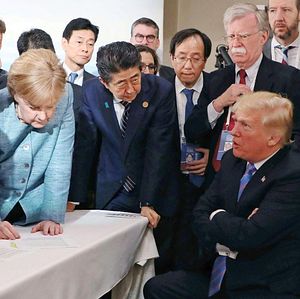This past weekend, U.S. President Donald J. Trump announced that the upcoming summit of the Group of Seven would be postponed until September. He added that the meeting would take place around the United Nations General Assembly’s general debate — on either side of the event.
What drew considerable attention, however, was Trump’s set of comments suggesting that the G-7 should be expanded. “I don’t feel that as a G-7 it properly represents what’s going on in the world. It’s a very outdated group of countries,” Trump told reporters gathered on Air Force One.
Instead, he suggested that other countries, including Russia, South Korea, Australia, and India should be included. The suggestion to add Russia was immediately controversial, given that the Group of Seven was born of the former Group of Eight, which included Russia. The other seven members excluded Moscow from the grouping after its unilateral seizure of Ukraine’s Crimea in 2014.
But the suggested addition of two U.S. liberal-democratic treaty allies, Australia and South Korea, and India, an important U.S. partner, have raised eyebrows in these capitals — mostly in a positive way.
There’s no real reason this couldn’t happen. The Group of Seven, since Russia’s expulsion, has been a loosely associated group of large, industrialized countries.
Comprising the United States, the United Kingdom, France, Germany, Italy, Japan, and Canada (and the European Union), the group meets annually to discuss a range of global issues, managing to usually find a common stance.
In recent years, there have been more than a few road bumps. The Trump administration’s “America First” agenda made it difficult for the countries to release the sorts of statements they had in the past, particularly when it came to the issues of climate change and free trade, where the United States is an outlier.
The Trump proposal may find takers in the proposed new additions, which would together make the new group a Group of Eleven, or G-11. But there are risks.
For instance, even as the United States’ new foreign policy preferences have made joint statements a little more difficult than they were before 2017, the additional of new countries may complicate the agenda in new ways.
One of the obvious attractions for Trump of having the four proposed countries at the table is the possibility of having a forum to discuss China. In multilateral terms, adding India and Australia would allow a new G-11 to subsume the “quadrilateral” of the United States, Japan, Australia, and India, providing yet another forum in which these four democracies could interact.
But more countries means a broader agenda. India, for instance, may take a different stand from the other participating countries on issues related to trade, where New Delhi continues to be reticent about full-scale liberalization.
Either way, the suggestion of adding Russia makes Trump’s proposal a nonstarter for the remaining members of the G-7 — notably the four Europeans and Canada. If the proposal can be disaggregated, Australia, South Korea, and India, however, may have the interest — and ability — to see through a modest expansion.
There is also the question of whether an expanded G-7 may lack the sufficient cohesion to justify its existence alongside the Group of 20, which is a broader group of 20 economies — with less in common ideologically — focused on global economic coordination.
Given the already-existing rifts within the G-7, an expansion simply might not make sense.

































